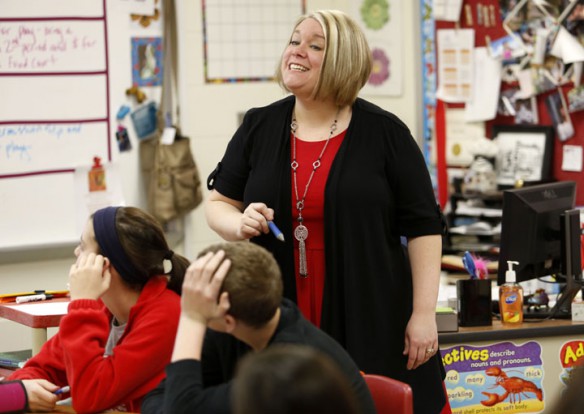
Holly Pitts teaches prepositions to her 7th-grade language arts class at Beechwood High School (Beechwood Independent). Pitts flips her classroom and has students watch short videos at home to aid in instruction. Photo by Amy Wallot, Feb. 13, 2013
By Susan Riddell
susan.riddell@education.ky.gov
Parents are routinely joking with teacher Holly Pitts about how they hear her voice in their homes all the time.
“The feedback I get from parents is actually great,” said Pitts, a 7th-grade language arts teacher at Beechwood High School. “I love knowing that students are learning some concepts before I really go over them in class.”
Pitts is one of several Kentucky teachers who have flipped their classroom. In a flipped classroom, students are introduced to concepts at home prior to classroom work on the topic.
“I love teaching this way,” Pitts said. “Kids are so social media driven these days, it makes perfect sense to me.”
Typically, teachers start new lessons by having students watch short five- to 15-minute videos at home and doing any necessary work prior to teachers going over the lessons in class.
Pitts relies on Edmodo for her students to gain access to the videos. She said she likes introducing new concepts to students this way, especially something visual and challenging like diagramming sentences.
Accommodations are made for students who don’t have computers at home. “I always try to give the kids a few days’ notice to watch the videos,” Pitts said. “They can watch them in a library or on phones.”
Like Pitts, Steve Mintner has had great feedback from parents about his flipped classroom. Mintner teaches science at South Middle School (Henderson County).
He said that with technology’s advancement the last several decades, a flipped classroom can help bridge the gap that some parents face in how they were taught compared to how students are taught today.
“It is often that parents of middle school students do not have the background to help their children, and this gives them the ability to sit down with the video and help their child,” Mintner said. “Parents really like (the videos).”
Mintner has been creating videos and using other science videos for his flipped classroom since last year. He does do a quick run-through of the material in class prior to students watching the videos. But students are responsible for watching them promptly, he said.
“It’s also very helpful for kids who are absent or sent to in-school suspension,” Mintner said.
Mintner said he plans to upgrade his videos soon by shortening them and having each one focus on a single topic. He also plans to include students in future videos.
“Morning radio shows always have two personalities,” Mintner said. “I think the videos will be more appealing with two of us in them.”
Teachers who flip their classrooms tend to offer two videos per week. But that doesn’t mean they don’t interact one-on-one with their students.
“We have built tutoring into our schedule two days per week, and I am always available before and after school,” Mintner said. “I will always help a kid who struggles with the concepts. I have started making online games on Quia.com and flashcards on Quizlet to help them, too.”
With the flipped model, Mintner said he has more classroom time for labs.
“There were a very high percentage of students who were proficient or distinguished on K-PREP last year,” he said. “I think the more active classroom labs played a key role in that since science can be so abstract, and we were able to make it more concrete.”
Pitts said the flipped classroom really benefits the struggling student.
“The videos allow kids to get extra help without feeling like they are way behind their classmates,” said Pitts, who will present her flipped classroom model at the Kentucky Society for Technology in Education beginning tomorrow.
Taylor County Middle School pre-algebra teacher Jessica McCubbin agreed that flipping a classroom benefits the struggling student.
“Students can rewind me and listen to instruction as many times as they need to,” McCubbin said of students who struggle to grasp concepts at initial viewings. “It promotes ownership of their learning as they are responsible for learning the material, doing the work, checking their work and asking questions if needed.”
McCubbin noted the method doesn’t hold back students who understand the concepts quickly and are ready to proceed with another lesson.
“We use a flipped self-paced model in which the student can go as far as they can once they master a concept, and they don’t have to wait on other students in the class.”
Laura Raganas has used a flipped classroom with 4th and 5th graders at Taylor County Elementary School.
Raganas, who relies on self-made, YouTube and Kahn Academy videos, said she begins her day with a 10- to15-minute, whole-group lesson followed by a short lesson that adheres to her pacing map.
“For the student who is working ahead, the mini lesson is a spiraling back (review) and for the student who may not be there yet, it’s a preview.” After the mini-lesson, students start learning material at their own pace.
Raganas requires all her students to journal her lessons in case they review it later, and students need to refer back to the lessons.
At first, Raganas was hesitant to embrace the flipped classroom model because she had concerns about her students being too young to be successful with it.
“I quickly saw that this is how this generation learns,” she said.
MORE INFO …
Holly Pitts, holly.pitts@beechwood.kyschools.us, (859)-331-1220, ext. 6405
Steve Mintner, dennis.mintner@henderson.kyschools.us, (270) 831-5050
Jessica McCubbin, Jessica.mccubbin@taylor.kyschools.us, (270) 465-2877
Laura Raganas, laura.raganas@taylor.kyschools.us, (270) 465-5691



Leave A Comment